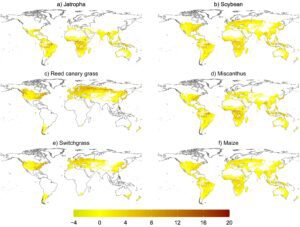New GIFTS-related publication reveals detailed CO2 emission estimates from land conversion into six feedstocks for Sustainable Aviation Fuel (SAF) production, showing significant global variations driven by yields and land carbon stocks. Results indicate areas that reduce life cycle greenhouse gas (GHG) emissions relative to fossil kerosene and estimate how long it takes to offset land use change emissions.
Combining spatially explicit data, researchers calculate CO2 emissions from Direct Land Use Change (DLUC) due to the on-site conversion of previous land uses into alternative SAF feedstocks, according to the sustainability criteria of the Carbon Offsetting and Reduction Scheme for International Aviation (CORSIA). CORSIA mandates that airlines offset their GHG emissions above 2019 levels through carbon offsets or the use of SAFs. These are jet fuels derived from biomass or renewable resources that reduce GHG emissions by at least 10% compared to conventional kerosene and are not produced at the cost of primary forests, peatlands, wetlands, and biodiversity-rich areas.
This study, led by Neus Escobar, provides DLUC values and carbon payback times at a 0.5-degree resolution for six SAF pathways, revealing critical insights into the environmental viability of these fuels. Across CORSIA-compliant areas, soybean-based jet fuel has the highest emissions, while jatropha has the lowest. Notably, perennials such as miscanthus, switchgrass, and jatropha have strong potential to cut GHG emissions over large areas. The findings, obtained for the first time in a spatially explicit manner, indicate wide variability in GHG emission intensities across agronomically suitable areas. The research underscores the importance of producing SAFs in areas where carbon stocks are low, and yields are high to maximize the GHG benefits. This study serves as a crucial tool for policymakers and industry stakeholders, providing detailed data to support the sustainable growth of the aviation sector. By identifying regions where SAF production can be scaled up for lower GHG emissions, the findings aid in meeting CORSIA’s sustainability criteria and promoting carbon-neutral growth in aviation.


Publication details:
Title: Spatially-explicit land use change emissions and carbon payback times of biofuels under the Carbon Offsetting and Reduction Scheme for International Aviation (CORSIA)
Link: https://www.sciencedirect.com/science/article/pii/S0048969724047843



